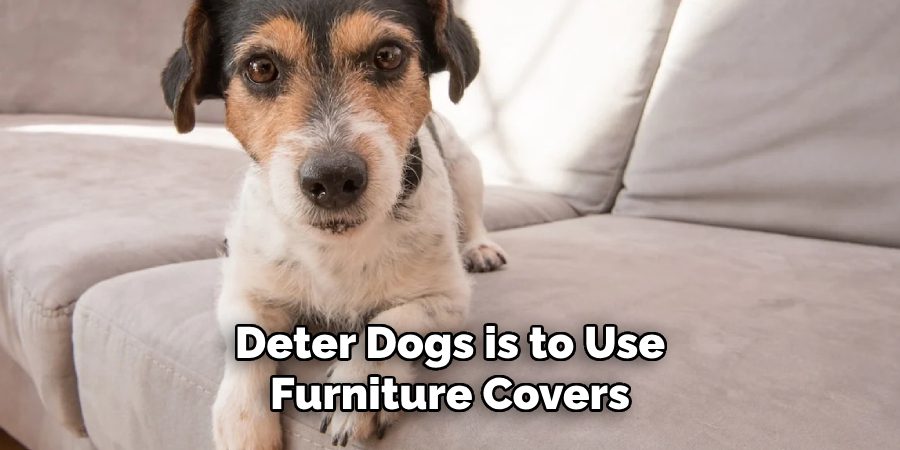Patio furniture provides a great way to relax outdoors, whether you’re enjoying a quiet morning with a cup of coffee or hosting friends and family. However, it’s not uncommon for dogs to see patio furniture as their personal lounging spot, which can lead to damage, dirt, and wear over time. Scratches, fur, and muddy paw prints can quickly diminish the appeal and lifespan of your

outdoor furniture. That’s why knowing how to keep dogs off patio furniture is essential for maintaining the cleanliness and longevity of your space. This guide provides effective strategies and tips for deterring dogs from climbing onto your patio furniture while ensuring they stay happy and comfortable. Whether through proper training, deterrents, or introducing alternative spots for your dog to relax, you can create a solution that balances your pet’s needs with the care of your outdoor area.
Understanding Why Dogs Love Patio Furniture
Comfort and Elevation
Dogs are naturally drawn to comfortable, elevated spaces and patio furniture offers the perfect combination of both. Cushioned surfaces provide a cozy place for dogs to rest, especially compared to the harder or less inviting outdoor options. Additionally, the elevated position of patio furniture allows dogs to gain a better vantage point of their surroundings, which ties back to their instinctive desire to survey their environment for potential threats or excitement. The texture and warmth of outdoor fabrics also invite dogs, especially on cooler days when the furniture may retain heat from the sun, making it even more appealing as a lounging spot.
Seeking Attention or Territory
For some dogs, climbing onto patio furniture is more than just about comfort—it’s also a way to assert themselves or seek attention from their owners. Dogs are social animals, and they often want to be as close to their human family as possible, especially during gatherings or when people are spending time outdoors. By being on the furniture, dogs feel included and

visible. Additionally, dogs may view the furniture as part of their territory, marking it or simply asserting their presence as a way to communicate their sense of ownership. Understanding these behaviors is key to addressing their desire for the furniture in a way that works for both you and your pet.
How to Keep Dogs Off Patio Furniture: Train Your Dog to Stay Off Furniture
Training is essential to prevent your dog from climbing onto patio furniture. Here’s a step-by-step approach to address the behavior effectively.
Step 1: Basic Obedience Training
Begin with basic obedience commands such as “Off” or “Leave it.” These commands help establish clear communication and expectations. When your dog climbs onto the furniture, calmly say “Off” and guide them back onto the ground if needed. Once they comply, immediately reward them with treats, praise, or affection to reinforce the desired behavior. Repetition is key to teaching your dog to associate staying off the furniture with positive outcomes.
Step 2: Consistency in Training
Consistency is critical when teaching your dog boundaries. Make sure everyone in the household adheres to the same rules regarding furniture access. If one person allows the dog to hop onto the furniture while others do not, this inconsistency can confuse the dog and hinder training progress. Clearly communicate the no-furniture rule to all family members and guests to maintain a unified approach. Dogs thrive on routine, so staying consistent will help solidify their understanding.
Step 3: Positive Reinforcement
Encourage your dog to seek out alternative lounging spots by providing comfortable, appealing options such as a cozy pet bed or blanket in a designated area. When your dog chooses to use their bed instead of the furniture, reward this decision with

treats, verbal praise, or gentle petting. Positive reinforcement helps to build a strong association between choosing alternative spaces and receiving rewards, making it easier to redirect them over time.
By implementing these steps, you can effectively train your dog to respect furniture boundaries while still ensuring they feel comfortable and included in your outdoor space.
How to Keep Dogs Off Patio Furniture: Use Deterrents to Keep Dogs Off Furniture
Deterrents can effectively train your dog to stay off furniture, offering non-confrontational methods to discourage the behavior. You can reinforce boundaries while protecting your furniture by using safe and strategic deterrents.
Step 1: Commercial Deterrent Sprays
Citrus-based sprays or commercial repellents are a widely available solution to deter dogs from climbing on furniture. Dogs typically dislike citrus scents, making these sprays an effective, harmless tool for shaping their behavior. Apply the deterrent spray to furniture surfaces, focusing on areas where your dog tends to jump or lounge. Reapply as needed to maintain its effectiveness while ensuring you follow the product’s instructions for safe use.
Step 2: DIY Deterrent Solutions
If you prefer a natural or more cost-effective option, create your own deterrent spray at home. Mixing equal parts vinegar and water or combining lemon juice with water can produce a safe and effective repellent. Before applying it to surfaces, test the solution on a small, inconspicuous furniture area to ensure it won’t cause discoloration or damage. Regularly refresh the application for continued effectiveness, particularly after cleaning or prolonged use.
Step 3: Furniture Covers and Slipcovers
Another effective method to deter dogs is to use furniture covers or slipcovers. Opt for covers made from materials that are difficult for dogs to grip or climb and can be easily removed when needed. These covers make furniture less appealing for pets

and protect against scratches, fur, and accidental messes. Using durable, pet-friendly materials ensures a balance between maintaining your furniture’s longevity and keeping your dog comfortable.
By integrating these deterrents into your training routine, you provide clear boundaries for your dog while maintaining a pet-friendly household.
Create an Alternative Comfortable Space for Dogs
Step 1: Provide Pet Beds or Cushions
Offer a comfortable dog bed or cushion near the patio furniture so your dog has its own space. This will help redirect their attention away from your furniture while still ensuring their comfort. Opt for beds or cushions made from weather-resistant materials if you plan to leave them outdoors for extended periods. To make the space more inviting, place it in a shaded area where your dog can relax away from direct sunlight. Positioning the bed or cushion near where you usually sit can also give the dog a sense of inclusion and companionship, mirroring the comfort they may seek from being close to you.
Step 2: Designated Pet Area
Creating a specific outdoor area for your dog with their favorite toys, a water bowl, and a soft blanket can provide an engaging and comfortable environment for them. Use barriers or dog playpens to establish clear boundaries, especially in shared spaces

like patios. This keeps your dog safe and redirects their energy toward playing or resting in their designated zone. Regularly updating the area with fresh toys or treats can keep it exciting and encourage your pet to stay within their alternative space. Providing these options makes your patio furniture less appealing while ensuring your dog’s needs are met.
Use Physical Barriers or Furniture Adjustments
Step 1: Pet Barriers
Place pet gates or barriers around patio furniture to create a clear physical boundary that prevents your dog from jumping up. These barriers are beneficial if your dog habitually climbs onto the furniture when unattended. Additionally, consider choosing furniture designs with higher, tighter sides or armrests, which may naturally deter your dog from attempting to jump on them. This approach minimizes frustration for both you and your pet while maintaining the aesthetics of your patio.
Step 2: Furniture with Slippery Surfaces
Opting for patio furniture with smooth or slippery surfaces, such as metal or wicker, can make it harder for dogs to grip or find comfort on them. These materials are less appealing for climbing or lounging, which can reduce the chances of your dog attempting to sit or lay on the furniture. If changing furniture isn’t an immediate option, you can use plastic slipcovers on existing pieces. These covers protect your furniture and create a less cozy surface that discourages your dog from staying on.
Step 3: Cover Furniture with Aluminum Foil or Plastic
Another effective tactic is to temporarily cover your patio furniture with aluminum foil or plastic sheets when the furniture is not in use. Many dogs dislike the sensation and noise of these materials, which can deter them from jumping up. Over time, this method can help condition your pet to avoid the furniture altogether, reducing unwanted behavior while ensuring your space remains pet-friendly and functional.
Making the Patio Less Appealing to Dogs
Remove Scent Triggers
Dogs are often attracted to furniture because of familiar scents. To make your patio less appealing to them, regularly clean cushions and furniture to remove these smells. Use pet-safe cleaning solutions to wash outdoor cushions and fabrics effectively without harming your pet. Removing scent triggers helps reduce the likelihood of your dog associating the furniture with comfort or familiarity.
Keep Patio Furniture Clean
Maintaining clean furniture is another way to discourage your dog from climbing or lounging on it. Regularly clean your furniture to remove food crumbs or spills that might attract them. It’s also essential to avoid leaving food, trash, or dog toys

around the patio, as these items can pique your dog’s interest. A tidy patio environment makes it less inviting for your pet.
Keep Patio Areas Active and Engaging
Instead of focusing entirely on restricting your dog, make the patio less appealing by shifting their attention elsewhere. Provide engaging activities like outdoor toys, food puzzles, or games. Regular walks and playtime can also help burn off energy and reduce their interest in your furniture. An active and fulfilled dog is less likely to seek out the patio furniture as a resting spot.
Common Mistakes to Avoid
One common mistake is punishing your dog after the fact. Dogs don’t understand delayed punishment, and scolding them hours later only creates confusion and fear. Consistency in training is also crucial; allowing your dog on the furniture occasionally sends mixed signals, making it harder for them to learn. Another significant mistake is failing to provide alternatives. If your dog is accustomed to climbing on patio furniture, offering a similarly comfortable alternative, like a pet bed or designated resting spot, is essential. Avoiding these mistakes can go a long way in reinforcing positive behaviors and maintaining your furniture’s condition.
Conclusion
To recap, learning how to keep dogs off patio furniture requires a combination of training, deterrents, physical barriers, and providing alternative spaces. Patience and consistency are fundamental to achieving lasting results. By following these strategies, you can create an outdoor space that your dog enjoys while protecting your patio furniture from damage. Balancing comfort for both you and your dog ensures a harmonious and enjoyable outdoor environment.

Professional Focus
Oliver Wood, a passionate patio designer, specializes in creating comfortable and inviting outdoor spaces that enhance relaxation and entertainment. His work combines a deep understanding of design with a love for nature, making him a standout professional in the field of outdoor living spaces. Through his thoughtful approach, he transforms everyday patios into extraordinary retreats for family and friends.
About the Author
Oliver Wood, a skilled patio designer, shares his expertise on outdoor living through his designs and insights. With a background in patio design and a genuine passion for creating beautiful spaces, he encourages others to invest in their outdoor environments, enhancing their homes with functional and inviting spaces for relaxation and entertainment.
Education History
University: Virginia Union University
Oliver’s education equipped him with the knowledge and skills to design patios that merge aesthetics with comfort, transforming outdoor areas into beautiful extensions of the home.
Expertise:
- Patio Design and Outdoor Living Spaces
- Functional and Aesthetic Landscaping
- Comfortable and Inviting Outdoor Environments
- Design Philosophy for Family-Oriented Spaces
- Creating Spaces for Relaxation and Entertainment
